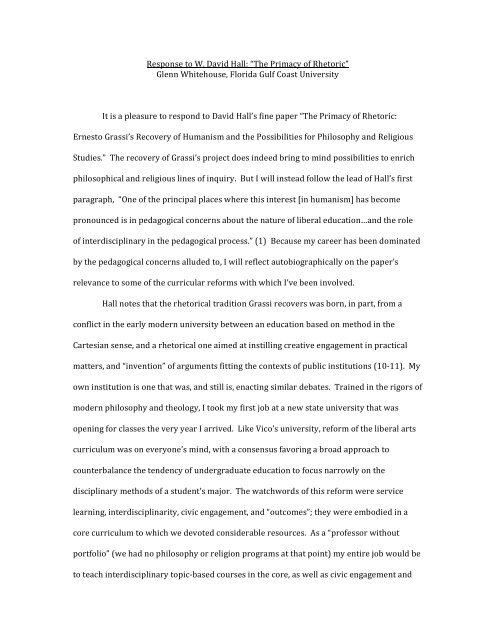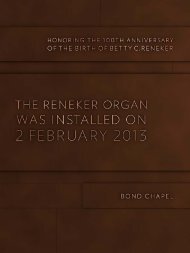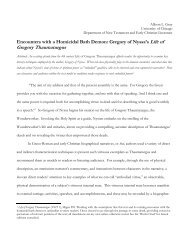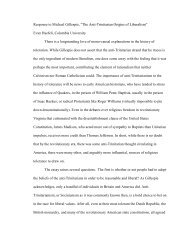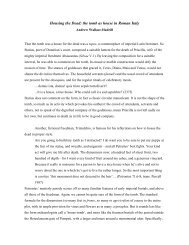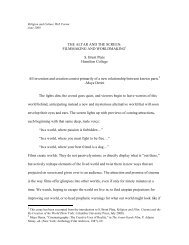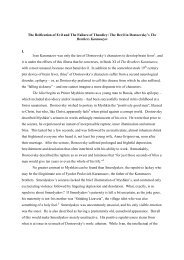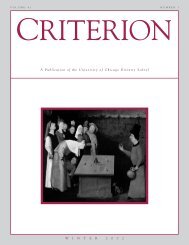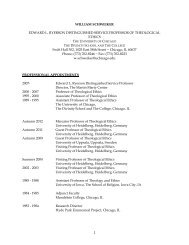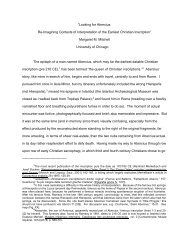Response to W. David Hall: “The Primacy of Rhetoric” Glenn ...
Response to W. David Hall: “The Primacy of Rhetoric” Glenn ...
Response to W. David Hall: “The Primacy of Rhetoric” Glenn ...
Create successful ePaper yourself
Turn your PDF publications into a flip-book with our unique Google optimized e-Paper software.
<br />
<strong>Response</strong> <strong>to</strong> W. <strong>David</strong> <strong>Hall</strong>: <strong>“The</strong> <strong>Primacy</strong> <strong>of</strong> Rhe<strong>to</strong>ric” <br />
<strong>Glenn</strong> Whitehouse, Florida Gulf Coast University <br />
<br />
It is a pleasure <strong>to</strong> respond <strong>to</strong> <strong>David</strong> <strong>Hall</strong>’s fine paper <strong>“The</strong> <strong>Primacy</strong> <strong>of</strong> Rhe<strong>to</strong>ric: <br />
Ernes<strong>to</strong> Grassi’s Recovery <strong>of</strong> Humanism and the Possibilities for Philosophy and Religious <br />
Studies.” The recovery <strong>of</strong> Grassi’s project does indeed bring <strong>to</strong> mind possibilities <strong>to</strong> enrich <br />
philosophical and religious lines <strong>of</strong> inquiry. But I will instead follow the lead <strong>of</strong> <strong>Hall</strong>’s first <br />
paragraph, “One <strong>of</strong> the principal places where this interest [in humanism] has become <br />
pronounced is in pedagogical concerns about the nature <strong>of</strong> liberal education…and the role <br />
<strong>of</strong> interdisciplinary in the pedagogical process.” (1) Because my career has been dominated <br />
by the pedagogical concerns alluded <strong>to</strong>, I will reflect au<strong>to</strong>biographically on the paper’s <br />
relevance <strong>to</strong> some <strong>of</strong> the curricular reforms with which I’ve been involved. <br />
<strong>Hall</strong> notes that the rhe<strong>to</strong>rical tradition Grassi recovers was born, in part, from a <br />
conflict in the early modern university between an education based on method in the <br />
Cartesian sense, and a rhe<strong>to</strong>rical one aimed at instilling creative engagement in practical <br />
matters, and “invention” <strong>of</strong> arguments fitting the contexts <strong>of</strong> public institutions (10‐11). My <br />
own institution is one that was, and still is, enacting similar debates. Trained in the rigors <strong>of</strong> <br />
modern philosophy and theology, I <strong>to</strong>ok my first job at a new state university that was <br />
opening for classes the very year I arrived. Like Vico’s university, reform <strong>of</strong> the liberal arts <br />
curriculum was on everyone’s mind, with a consensus favoring a broad approach <strong>to</strong> <br />
counterbalance the tendency <strong>of</strong> undergraduate education <strong>to</strong> focus narrowly on the <br />
disciplinary methods <strong>of</strong> a student’s major. The watchwords <strong>of</strong> this reform were service <br />
learning, interdisciplinarity, civic engagement, and “outcomes”; they were embodied in a <br />
core curriculum <strong>to</strong> which we devoted considerable resources. As a “pr<strong>of</strong>essor without <br />
portfolio” (we had no philosophy or religion programs at that point) my entire job would be <br />
<strong>to</strong> teach interdisciplinary <strong>to</strong>pic‐based courses in the core, as well as civic engagement and
critical thinking. Soon, I also became involved in creating an interdisciplinary <br />
Communication major based on a “new trivium” combining philosophy, speech <br />
communication, and rhe<strong>to</strong>ric. In the classroom and the curriculum committee, I had <br />
become a partisan for the sort <strong>of</strong> humanistically inspired educational reform that <strong>Hall</strong> <br />
alludes <strong>to</strong>. His reading <strong>of</strong> Grassi sheds light on the successes <strong>of</strong> this effort, as well as some <strong>of</strong> <br />
the places we fell short. <br />
First, I would refer <strong>to</strong> the idea <strong>of</strong> ingenium or inventiveness as creative response <strong>to</strong> <br />
necessity; a capacity that, in humans, lends meaning <strong>to</strong> language and gives the “arts” their <br />
purpose (7‐8). In many ways, the civic engagement courses anchoring the core curriculum <br />
in my institution were an attempt <strong>to</strong> train ingenium, or at any rate <strong>to</strong> unleash it. These <br />
courses utilized service learning projects and “real assessments,” in which students were <br />
thrown in<strong>to</strong> actual or simulated practical contexts (necessity) and asked <strong>to</strong> invent <br />
responses <strong>to</strong> the problems they identified therein (ingenium). Students have done <br />
surprisingly well at this, producing projects that both fulfilled the outcomes set by faculty, <br />
and impressed external community agencies. <strong>Hall</strong> notes that for Grassi and Vico, ingenium <br />
is also tied integrally <strong>to</strong> rhe<strong>to</strong>ric, inasmuch as rhe<strong>to</strong>ric trains its users <strong>to</strong> “find the <strong>to</strong>pics” <br />
that will work in a given discursive situation and trains the mind <strong>to</strong> respond imaginatively <br />
<strong>to</strong> actual practical contexts, in contrast <strong>to</strong> the abstractions <strong>of</strong> method (9‐10). Interestingly, <br />
our civic engagement course paired the hands‐on projects with a unit on critical thinking, <br />
using a textbook that showcased a set <strong>of</strong> analytical categories that essentially were taken <br />
from the classical list <strong>of</strong> <strong>to</strong>pics, even if they were not named as such. Students were <br />
prompted <strong>to</strong> approach their service projects using the <strong>to</strong>ols acquired in the critical thinking <br />
unit. I am convinced that the critical thinking exercises helped the students respond <br />
inventively <strong>to</strong> their practical tasks; but as an academic exercise, the results were rather <br />
disappointing—students were not, generally, able <strong>to</strong> come back <strong>to</strong> the classroom and apply
this sophisticated rhe<strong>to</strong>rical analyses <strong>to</strong> texts, nor did they improve greatly in <br />
argumentative skills. Our ambition <strong>to</strong> use rhe<strong>to</strong>ric <strong>to</strong> lay an intellectual foundation that <br />
would be fruitful for interdisciplinary academic work went largely unrealized, however <br />
fruitful the civic and practical results were. <br />
I find some insight in<strong>to</strong> this shortcoming in the third stage <strong>of</strong> Grassi’s humanism—<br />
namely the interaction between the call <strong>of</strong> metaphor and the response given by sensus <br />
communis or common sense. As <strong>Hall</strong> points out, the rhe<strong>to</strong>rical or “<strong>to</strong>pical” approach <strong>to</strong> <br />
liberal education ultimately aims not <strong>to</strong> give a recipe for persuasion, but <strong>to</strong> awaken our <br />
capacities <strong>to</strong> use imagination, <strong>to</strong> perceive similarities, <strong>to</strong> think and speak metaphorically <br />
(11‐12). But metaphorical imagination by itself risks falling in<strong>to</strong> an undisciplined <br />
subjectivism without the stabilization provided by sensus communis, the s<strong>to</strong>re <strong>of</strong> <br />
unreflective judgments that sort out which metaphors “work” in the contexts <strong>of</strong> shared <br />
institutions and understandings (14). I read this as a diagnosis <strong>of</strong> the failure <strong>of</strong> my <br />
institution <strong>to</strong> connect the rhe<strong>to</strong>rical training <strong>of</strong> our core curriculum back <strong>to</strong> the students’ <br />
academic majors. Our courses prepared students <strong>to</strong> think imaginatively in practical <br />
contexts, and <strong>to</strong> approach “<strong>to</strong>pics” in a nondisciplinary way, but without a structural <br />
connection back <strong>to</strong> the “common sense” <strong>of</strong> the students’ major disciplines, their academic <br />
applications <strong>of</strong> our liberal arts core <strong>to</strong>o <strong>of</strong>ten amounted <strong>to</strong> little more than idiosyncratic <br />
observations or easy subjective relativism. By sequestering the core curriculum in core <br />
courses, we ultimately limited the reach <strong>of</strong> the humanistic reform we sought, instead <strong>of</strong> <br />
realizing our hope that this approach would leaven the teaching <strong>of</strong> the disciplines and lead <br />
<strong>to</strong> substantive interdisciplinary education. <br />
Finally, I find that <strong>Hall</strong>’s paper sheds retrospective light on our approach <strong>to</strong> the <br />
Philosophy major, when we finally got one. Having come through the experience <strong>of</strong> the <br />
common core, my colleagues and I set out <strong>to</strong> create a philosophy major that, I can now
ecognize, stresses humanist “<strong>to</strong>pical philosophy” over the rationalist tradition represented <br />
by Descartes or analytic philosophy (8). This comes out in a few ways: our logic course is <br />
on logic and disputation, placing the formal study <strong>of</strong> reasoning firmly within the practical <br />
context <strong>of</strong> real debate; in our courses on philosophical method, far from dismissing rhe<strong>to</strong>ric <br />
and metaphor in Cartesian fashion (9), we use rhe<strong>to</strong>rical forms (dialogue, aphorism, lecture, <br />
etc.) as a way <strong>to</strong> categorize the ways <strong>of</strong> doing philosophy; finally, we have been selfconsciously interdisciplinary in our course <strong>of</strong>ferings—which means a lot <strong>of</strong> “philosophy <br />
and…” titles—and along with this, a sense that philosophy is an extension <strong>of</strong> the human <br />
ingenium embodied in figurative language and practical arts (8), rather than a pure <br />
rationalism <strong>to</strong> be pursued in scholastic isolation. Like Grassi, we found that rhe<strong>to</strong>rical and <br />
humanistic concerns led us <strong>to</strong>ward a reconceptualization <strong>of</strong> philosophy, at least for <br />
purposes <strong>of</strong> pedagogy. <strong>David</strong> <strong>Hall</strong>’s recovery <strong>of</strong> Ernes<strong>to</strong> Grassi provides much food for <br />
thought for those trying <strong>to</strong> turn the recovery <strong>of</strong> humanism in<strong>to</strong> renewal <strong>of</strong> liberal education, <br />
and I’m thankful for the theoretical frame for some <strong>of</strong> my pedagogical projects.


